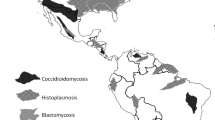Abstract
THE agar double diffusion precipitation reaction has been found of value in this laboratory in research on the organism of contagious bovine pleuropneumonia, Asterococcus mycoides. Two techniques are used, a modification of Ouehterlony's1 method described by Mansi2 and a method described by Jennings and Malone3. The reactions observed, and the interpretation of the results obtained, with the bovine pleuropneumonia organism have been essentially similar to those described by these authors. Jennings and Malone's method has the advantage that a positive reaction can be seen in 2 hr., and that more distinct separation of lines of precipitation occurs as diffusion proceeds; but larger quantities of serum and antigen are required than for the method of Mansi.
Similar content being viewed by others
References
Ouchterlony, O., Ark. For. Kemi Mineralogi. Oct. Geologi., 26, B, 1 (1948).
Mansi, W., J. Comp. Path., 67, 297 (1957).
Jennings, R. K., and Malone, F., J. Immunol., 72, 411 (1954).
Newing, C. R., and MacLeod, A. K., Nature, 177, 939 (1956).
Author information
Authors and Affiliations
Rights and permissions
About this article
Cite this article
WHITE, G. Agar Double Diffusion Precipitation Reaction applied to the Study of Asterococcus mycoides. Nature 181, 278–279 (1958). https://doi.org/10.1038/181278a0
Issue Date:
DOI: https://doi.org/10.1038/181278a0
- Springer Nature Limited
This article is cited by
-
A Galactan from Mycoplasma mycoides
Nature (1958)





